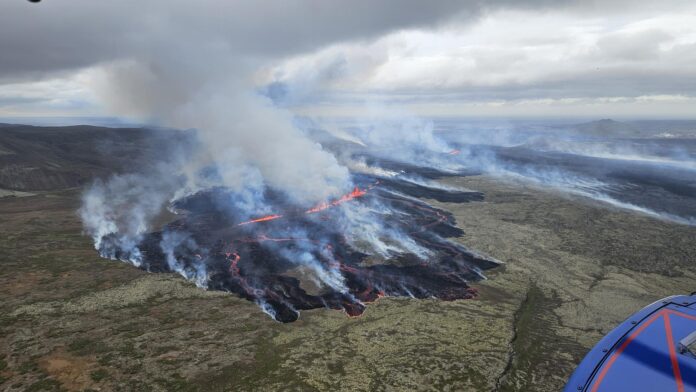It has been over 10 months since the on-again, off-again eruption near Grindavík in Iceland began. Since then, multiple eruptions have tapped a source of magma at the base of the crust under the island nation. That magma made its way to the surface to eruption as spectacular lava fountains and flows that have covered a significant area of real estate near the small fishing village and Blue Lagoon hydrothermal area.
Thankfully, there has been only one death from a worker falling into a crack while two other people have been injured from inhaling sulfur dioxide gas and unauthorized hiking onto the lava fields at night. This is a testament to Iceland’s ability to mitigate against any further harm through careful volcano monitoring.
Animated GIF of the eruption at Sundhnúkur over the past 9 months. Credit: Sentinel-2/ESA.
One positive aspect of the Sundhnúkur eruptions is that volcanologists have been able to watch the signs of impending eruption and then sample the lava that erupted across these events. This means that a time series can be constructed of both what happens during the time leading up to each new eruption and how the composition of the molten rock spilling onto the surface changes between and during eruptions.
Taking the Pulse of the Crust
The Icelandic Meteorological Office (IMO) has been using how much the ground deforms between eruptions to examine what is the threshold of magma intruding the crust before a new eruption starts. The amount the surface of the Earth inflates (rises) between eruptions can be modeled as an amount of magma filling up reservoirs in the crust.
By carefully tracking daily changes in the Earth’s surface (above), the IMO has been able to make curve that show how much inflation, and thus how much magma, it takes before a new eruption is triggered.
Days since last eruption compared with amount of magma accumulation (in millions of cubic meters) for the Sundhnúkur magmatic system in Iceland. Credit: IMO.
It turns out that over the course of the last year, that value has been fairly consistent. Of the 9 eruptions tracked, 8 of them commence after the system has recharged with 10-20 million cubic meters of magma (above). That works out to be ~8-15 Coliseums of Rome worth of molten rock.
The last eruption ended in early September, dumping ~60 million cubic meters of lava onto the surface. Based on deformation measurements since then, the system sits at ~4 million cubic meters (as of September 24, 2024) of magma accumulated. This might suggest there is a little more of a wait before the likelihood of a new eruption gets high.
The Source of all the Magma
With all these eruptions, volcanologists have been sampling lava across and between eruptions as well. We can look at the chemical and isotopic composition of lava to tell us things like the source of the molten rock in the mantle, the minerals that crystallize after the magma forms, the temperature, depth, and duration that the magma might have sat in the crust and how rapidly it make its way to the surface. A little geochemistry goes a long way towards understanding a volcanic system!
A study that just came out in Science by Simon Matthews and a cast of collaborators looks at just how simple or complicated the magmatic system under the Sundhnúkur eruptions might be. They found out that it might be much more complicated than we thought it would be.
Changes in potassium and titanium in the lavas erupted at Sundhnúkur in Iceland in 2024. Credit: Matthews and others, Science (2024).
Matthews and his collaborators examined the geochemical and isotopic composition of lava and minerals that erupted from the last 10 months of eruptions. They used certain elements that are not changed by minerals like olivine, pyroxene and plagioclase feldspar forming in the lava – in this case, potassium and titanium (above). The variability in those elements in the erupted lava likely reflect differences in the sources of the lava rather than anything that has happened to it since it formed.
Most people picture a big balloon of fully molten magma underneath a volcano, feeding lava up to the surface through a straw. Studies of different types of volcanoes all over the planet done over the past decade suggest that this isn’t the case. Instead, many volcanoes keep their magma in batches (reservoirs) that might mix magma and crystals right before an eruption.
No Big Vat
However, at volcanoes like those in Iceland and Hawai’i, much of the previous evidence suggested a “big vat” model might work. However, Matthews and others found that the lava erupted near Grindavík is surprisingly heterogenous in composition, suggesting that instead of a big vat, it too was stored as discrete, isolated batches that might be mixed and tapped at different times during an eruption.
In fact, the composition of the lava is so heterogenous that even the source of the magma — the melting mantle under Iceland — might be slightly different for each of these batches of magma. That makes for a complicated story where the source of the magma changes, the magma rises through the crust until it reaches ~5 kilometers from the surface where the reservoir fills. That’s what is being measured by the deformation of the crust. Then, these batches are tapped when the eruption starts, possibly mixing on the way up.
A volcano that taps lots of smaller batches of magma rather than a big vat will show different changes to the crust as those reservoirs fill. All of this work helps us better understand how magma gets stored underneath volcanoes before, during and after eruptions. This means our models for how likely an eruption could be in the works can be better refined.
Source : Discovermagazine














